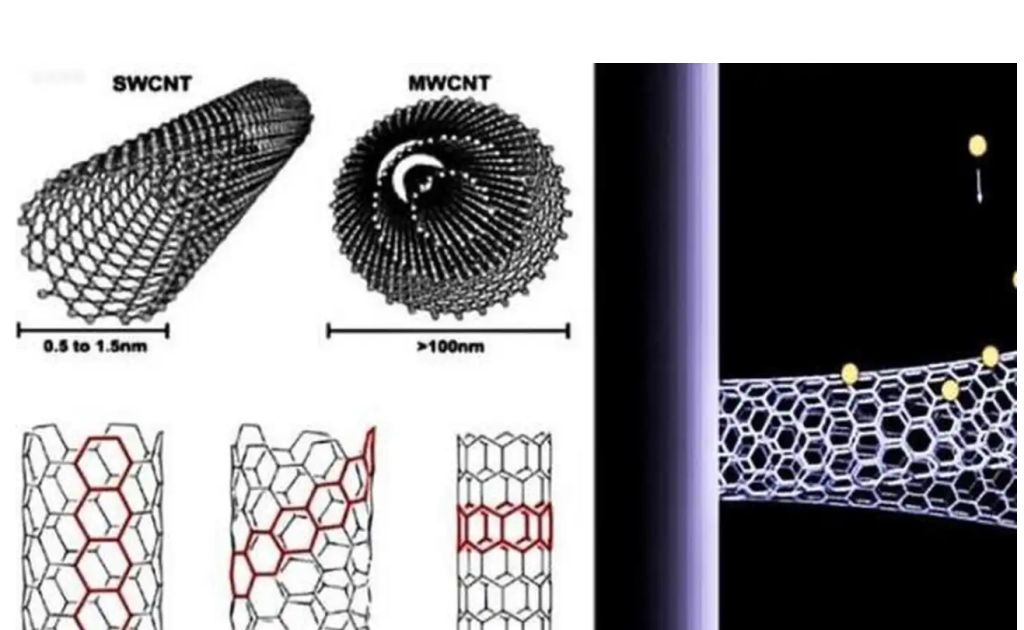Carbon Nanotubes as Reinforcement Agents in Composite Materials: Enhancing Strength and Durability
Carbon nanotubes (CNTs) have garnered significant attention as reinforcement agents in composite materials due to their extraordinary mechanical, thermal, and electrical properties. By integrating CNTs into resins, metals, and ceramics, engineers and scientists have developed composites with improved performance metrics, such as higher strength, durability, and multifunctionality. This article delves into how CNTs are used as reinforcements in various composite materials, highlighting their unique properties, real-world applications, and challenges.

How Carbon Nanotubes Enhance Composite Materials
Carbon nanotubes contribute to composite materials by improving their mechanical strength, toughness, and thermal and electrical conductivity. Their high aspect ratio, remarkable tensile strength (∼\sim63 GPa), and Young’s modulus (∼\sim1 TPa) make them ideal for reinforcing matrices. The most common composite materials enhanced by CNTs include:
1. Polymer Matrix Composites (PMCs)
CNTs are incorporated into polymers like epoxy, polyethylene, and polypropylene to enhance tensile strength, impact resistance, and electrical conductivity.
2. Metal Matrix Composites (MMCs)
CNTs reinforce metals such as aluminum, magnesium, and titanium, improving wear resistance, hardness, and thermal stability.
3. Ceramic Matrix Composites (CMCs)
Adding CNTs to ceramics like silicon carbide and alumina improves fracture toughness and thermal shock resistance.
Advantages of CNT-Reinforced Composites
1. Unmatched Mechanical Properties
- CNT-reinforced composites exhibit up to 50% higher tensile strength and 40% increased modulus compared to their unreinforced counterparts.
- For example, CNT-epoxy composites can achieve strengths of 200 MPa to 500 MPa, suitable for aerospace and automotive applications.
2. Lightweight Reinforcement
CNTs have a density of approximately 1.3−1.4 g/cm31.3-1.4 \, \text{g/cm}^3, which is significantly lower than traditional reinforcements like steel or glass fibers. This enables the production of lightweight yet durable materials.
3. Enhanced Thermal Conductivity
CNTs have a thermal conductivity of up to 3000 W/m·K, making them effective for heat dissipation in electronics and thermal barrier coatings.
4. Electrical Conductivity
Incorporating CNTs into insulating polymers can improve electrical conductivity, creating multifunctional materials for applications like electromagnetic interference (EMI) shielding.
5. Improved Fracture Toughness
CNTs reduce the brittleness of ceramics and polymers by enhancing energy absorption during deformation, thereby preventing catastrophic failure.
Real-World Applications
1. Aerospace and Defense
- CNT-reinforced composites are used in aircraft fuselages, wings, and propulsion systems to reduce weight and improve fuel efficiency.
- In defense, CNT composites are employed for lightweight body armor and reinforced structural components.
2. Automotive Industry
- CNT-polymer composites are used in car interiors, bumpers, and body panels to improve durability and reduce weight, enhancing fuel economy.
- CNT-metal composites are applied in engine parts for better heat resistance and mechanical performance.
3. Sports and Leisure Equipment
- CNT-reinforced composites are used in high-performance sports gear, such as tennis rackets, bicycles, and skis, to enhance strength while minimizing weight.
4. Electronics
- CNTs improve the thermal management and mechanical integrity of electronic packaging and printed circuit boards (PCBs).
- Flexible CNT-polymer composites are employed in wearable electronics and flexible displays.
5. Construction
- CNT-reinforced cement and concrete show improved compressive strength and crack resistance, contributing to more durable and sustainable infrastructure.
6. Biomedical Applications
- CNT composites are utilized in prosthetics, orthopedic implants, and dental materials due to their biocompatibility and mechanical strength.
Challenges in Using CNTs for Composite Reinforcement
1. Uniform Dispersion
- CNTs tend to agglomerate due to van der Waals forces, leading to uneven reinforcement. Advanced techniques like ultrasonication, ball milling, and surfactant-assisted dispersion are required to address this issue.
2. Interface Bonding
- The strength of CNT-reinforced composites depends heavily on the bonding between CNTs and the matrix. Surface functionalization techniques, such as oxidation or silanization, improve bonding but add complexity and cost.
3. Cost and Scalability
- CNT production remains expensive, particularly for single-walled carbon nanotubes (SWCNTs), limiting their widespread use in cost-sensitive industries.
4. Health and Environmental Concerns
- CNTs, particularly in powder form, pose potential risks to health and the environment during manufacturing and disposal. Developing safer handling and disposal methods is essential.
5. Processing Challenges
- The high aspect ratio of CNTs can lead to alignment issues during processing, affecting the uniformity and anisotropic properties of the final composite.
Market Trends and Growth
Global Market Value
The global carbon nanotube-reinforced composite market is expected to grow from USD 2 billion in 2023 to approximately USD 5 billion by 2030, driven by advancements in production techniques and the increasing demand for lightweight, high-performance materials.
Regional Insights
- North America leads in aerospace and defense applications.
- Asia-Pacific, particularly China, dominates in automotive and construction sectors due to cost-effective manufacturing.
- Europe focuses on renewable energy applications, such as wind turbine blades and solar panel components.
Key Players
Companies like Nanocyl, Arkema, and Toray Industries are leading innovation in CNT-reinforced composite development.
Future Prospects
The future of CNT-reinforced composites lies in overcoming current limitations through technological advancements:
- Cost Reduction: Scaling up production of high-quality CNTs to reduce costs.
- Advanced Functionalization: Developing novel surface treatments to enhance matrix bonding.
- Hybrid Materials: Combining CNTs with graphene, boron nitride, or other nanomaterials to create hybrid composites with superior properties.
- Sustainability: Innovating eco-friendly production methods and recyclable composites.
These advancements will unlock new applications in sectors such as renewable energy, space exploration, and next-generation transportation systems.
Conclusion
Carbon nanotubes have proven to be transformative as reinforcement agents in composite materials, enabling the creation of lighter, stronger, and more durable materials for a wide range of applications. Despite challenges related to cost, dispersion, and environmental concerns, ongoing research and innovation promise to expand their use across industries.
As the demand for high-performance and sustainable materials grows, CNT-reinforced composites will play a critical role in shaping the future of engineering and technology.

